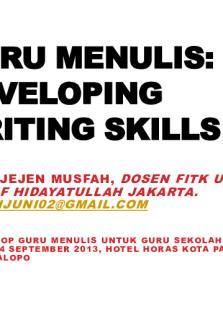Materials for developing writing skills DOC

| Title | Materials for developing writing skills |
|---|---|
| Author | Ken Hyland |
| Pages | 14 |
| File Size | 105.5 KB |
| File Type | DOC |
| Total Downloads | 27 |
| Total Views | 242 |
Summary
Hyland, K. (2014). Materials for developing writing skills. B. Tomlinson (ed.) Developing Materials for Language Teaching. London: Bloomsbury. pp 391-406. Materials for Developing Writing Skills Ken Hyland Introduction It is difficult to imagine how we might teach students to develop their writing s...
Description
Hyland, K. (2014). Materials for developing writing skills. B. Tomlinson (ed.) Developing Materials for Lan- guage Teaching. London: Bloomsbury. pp 391-406. Materials for Developing Writing Skills Ken Hyland Introduction It is difficult to imagine how we might teach students to develop their writing skills without using materials of some kind. Defining materials broadly as anything that can help facilitate the learning of language, we can see that they not only include paper and electronic resources, but also audio and visual aids, real objects and performance. Together with teaching methodologies, materials represent the interface between teaching and learning, the point at which needs, objectives and syllabuses are made tangible for both teachers and students. They provide most of the input and language exposure that learners receive in the classroom and are indispensable to how teachers stimulate, model and support writing. The choice of materials available to teachers is almost infinite, ranging from You- Tube clips to research articles, but their effectiveness ultimately depends on the role that they are re- quired to play in the instructional process and on the extent they relate to the learning needs of stu- dents. This chapter will consider both these issues and then go on to discuss using textbook and in- ternet materials and ways to develop materials. The Roles of Writing Materials Materials are used to provide a stimulus to writing, to assist students towards understanding the lan- guage they need to write effectively, and as ideas for organising lesson activities. In many contexts, moreover, language materials may be the only opportunities students have to study target texts. Table 1 lists the main roles of materials. Table 1: The roles of materials in writing instruction (Hyland, 2003) 1. Models: Sample text exemplars of rhetorical forms and structures of target genres. 2. Language scaffolding: Sources of language examples for discussion, analysis, exercises, etc. 3. Reference: Online or paper-based information, explanations and examples of relevant gram- matical, rhetorical or stylistic forms. 4. Stimulus: Sources which stimulate writing. Usually paper or internet texts, but can include video, graphic or audio material or items of realia 1...
Similar Free PDFs

Resume for Report Writing Skills
- 3 Pages

Writing Skills
- 29 Pages

Developing a Writing Habit
- 2 Pages

Developing Soft Skills in Students
- 10 Pages

Business Report Writing Skills
- 78 Pages

English Writing Skills
- 192 Pages
Popular Institutions
- Tinajero National High School - Annex
- Politeknik Caltex Riau
- Yokohama City University
- SGT University
- University of Al-Qadisiyah
- Divine Word College of Vigan
- Techniek College Rotterdam
- Universidade de Santiago
- Universiti Teknologi MARA Cawangan Johor Kampus Pasir Gudang
- Poltekkes Kemenkes Yogyakarta
- Baguio City National High School
- Colegio san marcos
- preparatoria uno
- Centro de Bachillerato Tecnológico Industrial y de Servicios No. 107
- Dalian Maritime University
- Quang Trung Secondary School
- Colegio Tecnológico en Informática
- Corporación Regional de Educación Superior
- Grupo CEDVA
- Dar Al Uloom University
- Centro de Estudios Preuniversitarios de la Universidad Nacional de Ingeniería
- 上智大学
- Aakash International School, Nuna Majara
- San Felipe Neri Catholic School
- Kang Chiao International School - New Taipei City
- Misamis Occidental National High School
- Institución Educativa Escuela Normal Juan Ladrilleros
- Kolehiyo ng Pantukan
- Batanes State College
- Instituto Continental
- Sekolah Menengah Kejuruan Kesehatan Kaltara (Tarakan)
- Colegio de La Inmaculada Concepcion - Cebu









